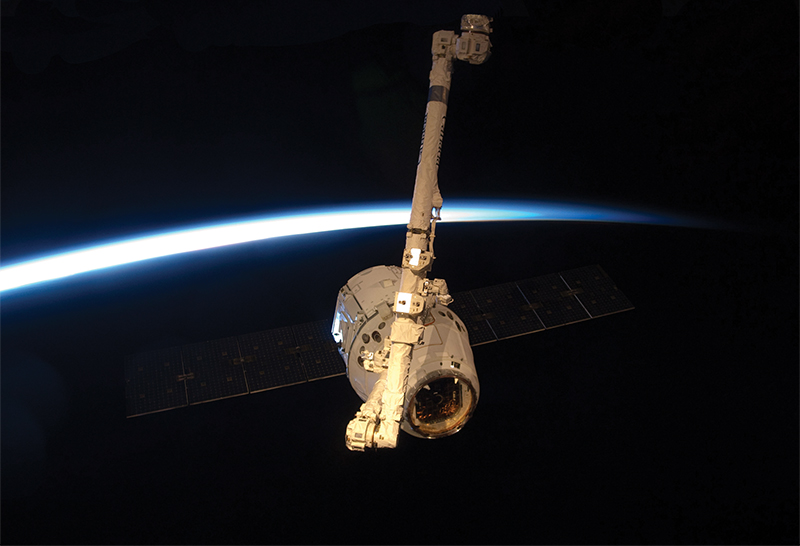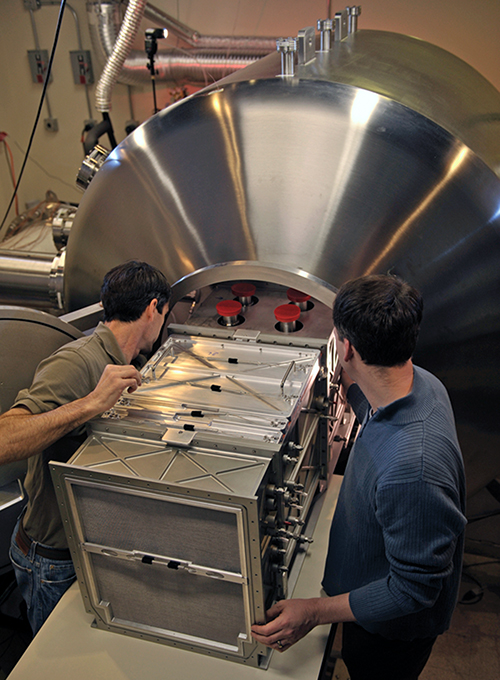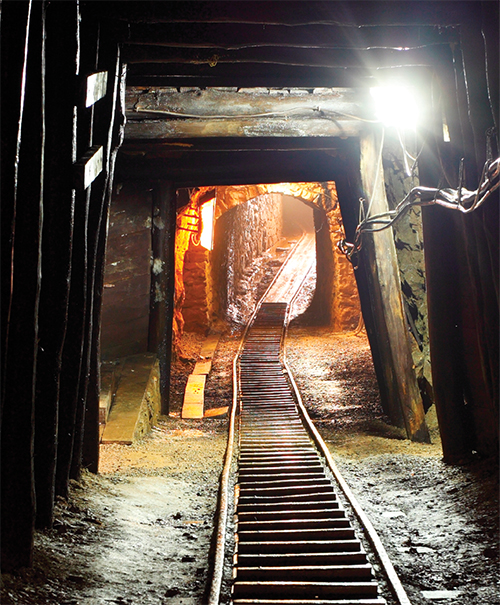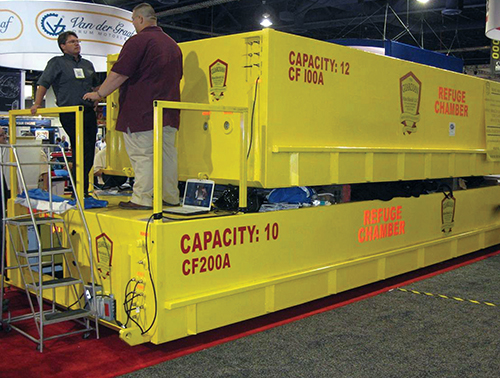
Air Systems Provide Life Support to Miners
NASA Technology
On July 21, 2011, the Space Shuttle Atlantis, having successfully completed a 13-day mission to ferry supplies and spare parts to the International Space Station (ISS), touched down on the Kennedy Space Center’s runway for the last time, marking the completion of NASA’s 30-year Space Shuttle Program. The Agency has set its sights on new horizons, such as sending humans to Mars and designing other spacecraft to explore the deeper reaches of the solar system. But one agency’s shift of focus can be the private sector’s gain.
Before their retirement, the space shuttles, as one of their main functions, transported American astronauts to and from the ISS. In their absence, crewmembers now hitch rides onboard the Russian Soyuz spacecraft. But over the last few years, NASA, in accordance with its goal of promoting commercial space flight, has partnered with several US companies under its Commercial Crew Development (CCDev) program to develop privately operated space vehicles and supporting technologies capable of fulfilling that transport role.
In 2009 NASA began accepting funding proposals for the first phase of its program. One of those companies, Paragon Space Development Corporation, offered to develop a critical piece of life support equipment: a compact air purification system.
For an astronaut, a spaceship’s interior is a protective cocoon that provides a breathable atmosphere, but it’s a bubble of air that must be constantly purged of impurities. Each NASA shuttle had been equipped with its own air revitalization system whose numerous components were dispersed throughout the vehicle. The company’s vision was to combine all of those discrete parts into a single, dependable module that could be installed onto any commercial spacecraft.
Paragon is no stranger to developing life support systems for extreme environments. The Tucson-based firm developed protective, deep-sea diving suits for the US Navy and is working on fabricating next-generation space suits for use in future NASA missions. Coincidentally, at the time company engineers were already developing an air purification system in anticipation of a future boom in commercial space transport.
“The timing was right for us to apply,” says Barry Finger, Paragon’s director of advanced concepts and business development.
NASA agreed, and in 2010 the two entities entered into a Space Act agreement.
“The NASA partnership with Paragon represented the optimal model of how you would want to stimulate the maturation of commercial space flight technology,” says NASA engineer Don Totton, who oversaw the project. “They had a very defined concept that they were trying to develop, which is a short duration environmental control and life support system that could be commercially utilized on different spacecraft in low earth orbital missions as an integrated package.”
It didn’t take long for results to arrive. Working in consultation with Agency engineers, in 10 months Paragon announced completion of the Commercial Crew Transport-Air Revitalization System (CCT-ARS)—an all-purpose unit containing no fewer than seven life-sustaining components: carbon dioxide removal, trace contaminant removal, air filtration, post-fire atmospheric recovery, cabin air circulation, a dehumidifier, and air temperature control.
Aside from the dehumidifying mechanism, which the company developed into a proprietary technology, Paragon’s chief contribution lies in making it possible for a single fan to circulate the air through all those subsystems.
“I would call it a trick,” Finger says, “but that’s not giving enough credit to the team. A lot of hard engineering was applied to make one fan do all of that.”
Yet for all that the CCT-ARS accomplishes, on a typical 60-hour trip to and from the ISS, the only maintenance required is a simple changing out of the carbon dioxide filters two, maybe three times.
Says Finger, “Other than that, you don’t have to touch the machine at all.”
Technology Transfer
Crewmembers endure a dark and dangerous environment. Clean air, an urgently important resource, must be artificially supplied within a protective chamber. Several days may pass before they return to the safety of the Earth’s surface.
This tableau could very well describe space travel, but there is another extreme circumstance that fits the bill—survival in the wake of a mining disaster.
From toxic fume leaks and gas explosions to flooding and earthquake collapses, mines are susceptible to any number of potentially life-threatening catastrophes. That’s why these deeply burrowed holes in the Earth are required by law to contain what are called refuge alternatives. The steel-clad shelter units are stocked with food, water, first aid kits, communication systems, and a steady supply of clean, temperature-controlled air. Enough provisions are housed in each chamber to sustain a crew for up to 4 days until help arrives.
Not long after Paragon announced completion of the CCT-ARS, made possible by partnering with NASA through a Space Act Agreement, the Mine Safety and Health Administration (MSHA), the federal agency responsible for enforcing health and safety regulations in the mining industry, saw the potential in having such a machine be operational in a refuge alternative. After being contacted by numerous companies that supply refuge alternatives, Paragon—following numerous meetings with MSHA officials, conducting independent research, and touring the Bailey Mine in Pennsylvania—agreed that its air revitalization system had much to offer, not just skyward in Earth’s orbit, but within its hollowed depths as well.
As a result, in March 2012 Paragon partnered with Lancaster, Kentucky-based refuge alternative builder Mineshield LLC, which purchased the licensing rights for 10 years to manufacture the air revitalization unit for its chambers.
Benefits
Recall what Paragon’s Barry Finger said, that, aside from changing out the carbon dioxide filters every so many hours, the machine doesn’t require any tampering or adjusting. That, in a nutshell, is the CCT-ARS’s major contribution to Mineshield’s refuge alternative chamber. And it’s a contribution that cannot be overestimated.
“After an explosion or an accident, it’s a very confusing time for the miners,” says Mineshield CEO Connie Hendren. “With this new module, we have taken any type of decision making away from the man, and all he has to do is get in there.”
This battery-operated unit, capable of operating nonstop for over 4 days, takes care of nearly everything else.
Although still a top-of-the-line product in the refuge alternative market, the company’s older generation system requires more upkeep during an emergency when compared to the CCT-ARS. While its carbon dioxide scrubbers need to be replaced every 12 hours or sooner, the newer system’s more efficient ones only require a changing out once every 24 hours. The older unit’s temperature control system—a traditional fan system that requires manual adjusting—is now automated by means of a liquid cooling unit that maintains the desired temperature. Another automated improvement over the older model is the oxygen distribution subsystem, which is programmed to sustain the optimal ratio of oxygen in the chamber.
The air revitalization system’s trace contaminant removal component is a welcomed addition to the refuge shelter, serving an accessory role to the new major contaminant purge system that miners pass through before entering the living area of the chamber. Although separate from the air revitalization unit, Paragon also developed that technology. The system works by having miners crawl, or rather squeeze through, inflated air duct barriers produced by the company, DuctSox. The fabric is an air diffuser, which, in this scenario, dispels contaminants from a miner’s body. Paragon engineers, by applying computational fluid dynamics, have ensured that enough of a positive pressure is created so that the contaminants are forced out through the front entrance and not entrained into the refuge alternative.
In addition to making the CCT-ARS module function more efficiently, the purge will save companies money in the long run. The older system requires using far more compressed air, which is costly to refill, and also limits the number of miners that can enter the shelter at any given time. Indeed, when all of the technology’s efficiencies are taken into account, Mineshield CEO Hendren says that by using its new alternative refuge, mining companies stand to save $30,000 per chamber in maintenance costs.
With the benefits of the new alternative refuge model so clearly defined, the mining community’s response shouldn’t be surprising.
“I tell you, everybody I’ve showed it to wants one,” says Hendren.
Many companies that bought the old model now want theirs retrofitted with the new technology. Other sectors such as the Department of Homeland Security and the Department of Defense are looking into using the chambers as safe rooms.
The uptick in business has allowed Mineshield to hire at least 30 new employees, and the firm plans to expand operations further in the near future.
And as for Paragon, the company’s star continues to rise. In November 2012, the Space Foundation declared the CCT-ARS a Certified Space Technology.
“It’s really an exciting time for the company,” says Paragon’s Finger. “We’re seeing a lot of applications for our products, both in space and in other markets.”

Paragon’s seven-person Commercial Crew Transport-Air Revitalization System (CCT-ARS) successfully completed testing for use in space environments.

From toxic fume leaks and gas explosions to flooding and earthquake collapses, mines are susceptible to any number of potentially life-threatening catastrophes.

Mineshield’s refuge alternative chambers can be fitted with the CCT-ARS, which simplifies what miners need to do to ensure their safety in an emergency.

The SpaceX Dragon commercial cargo craft is grappled by the Canadarm2 robotic arm at the International Space Station.













